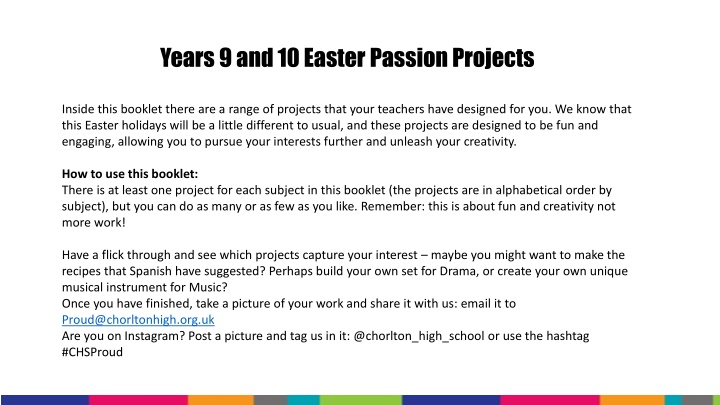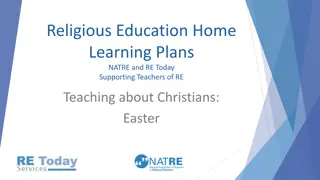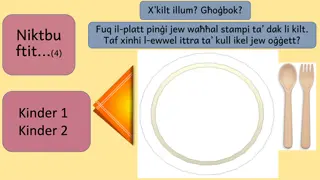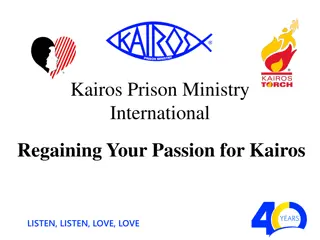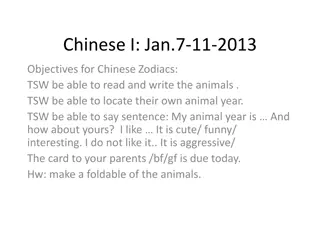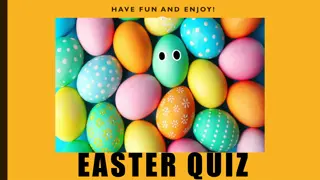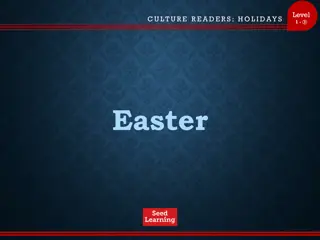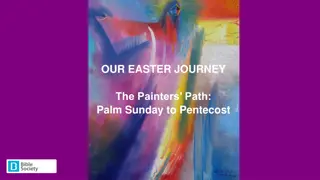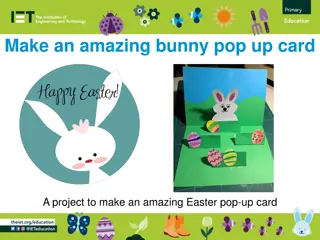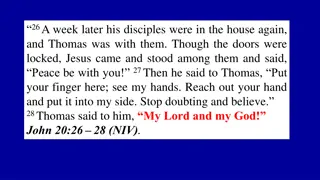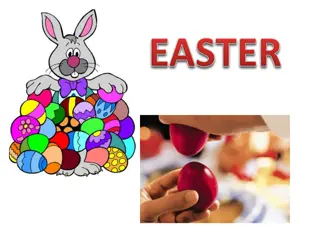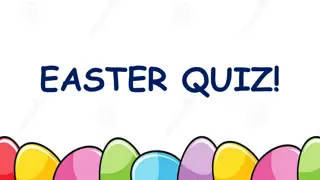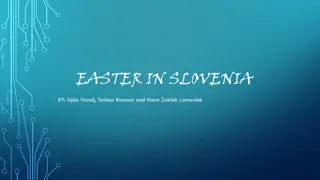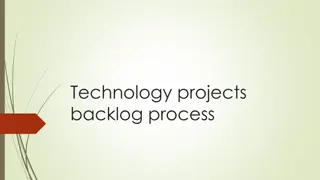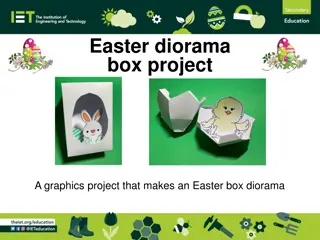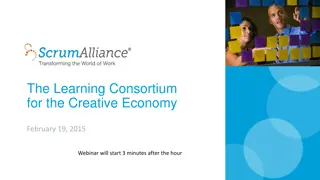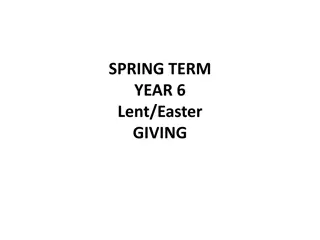Year 9 and 10 Easter Passion Projects: Fun and Creative Activities for Students
Discover a variety of engaging projects designed by teachers for Year 9 and 10 students to explore during the Easter holidays. Projects span different subjects like art, computing, and dance, encouraging creativity and fun. Students can recreate famous paintings, design websites, and create site-sensitive choreography, among other exciting activities. Share your completed projects with the school to showcase your creativity!
Download Presentation

Please find below an Image/Link to download the presentation.
The content on the website is provided AS IS for your information and personal use only. It may not be sold, licensed, or shared on other websites without obtaining consent from the author.If you encounter any issues during the download, it is possible that the publisher has removed the file from their server.
You are allowed to download the files provided on this website for personal or commercial use, subject to the condition that they are used lawfully. All files are the property of their respective owners.
The content on the website is provided AS IS for your information and personal use only. It may not be sold, licensed, or shared on other websites without obtaining consent from the author.
E N D
Presentation Transcript
Years 9 and 10 Easter Passion Projects Inside this booklet there are a range of projects that your teachers have designed for you. We know that this Easter holidays will be a little different to usual, and these projects are designed to be fun and engaging, allowing you to pursue your interests further and unleash your creativity. How to use this booklet: There is at least one project for each subject in this booklet (the projects are in alphabetical order by subject), but you can do as many or as few as you like. Remember: this is about fun and creativity not more work! Have a flick through and see which projects capture your interest maybe you might want to make the recipes that Spanish have suggested? Perhaps build your own set for Drama, or create your own unique musical instrument for Music? Once you have finished, take a picture of your work and share it with us: email it to Proud@chorltonhigh.org.uk Are you on Instagram? Post a picture and tag us in it: @chorlton_high_school or use the hashtag #CHSProud
ART Task: Recreate a famous painting Research and Planning: Research some of your favourite famous paintings Production: Have a look at some of the fun ways in which people have recreated famous paintings without using paint. You could dress up and pose like the example of The Marriage of Arnolfini below. Or recreate an image from clothes including towels, sheets and tea towels like The Girl with Pearl Earing or Banksy s Girl with Balloon. Remember to photograph it carefully from above. Have fun!
COMPUTING Task: Have you ever wondered what it takes to design a successful website? The creators of websites (web designers) get paid a lot of money for doing what they do. Here in Manchester there are hundreds of web designer jobs advertiser and it pays on average 40,000 a year! Way about the country's average salary. We want you to see if you have what it takes to develop your own websites looking at HTML language. Research and Planning: We have provided a lesson resource to support you in developing websites (see the personal development area of Doddle), thinking about the key features of a website. This will show you ways to develop titles, add images and format pages and background colours. Follow this lesson to learn more about web design and create your own using w3schools and the HTML tutorial. Production: Task 1: Create a web page that tells people about jobs in Computing. This could include web design, game designer, IT technician, computer engineer and graphic designers. Remember to include some adds on the page that takes people to different websites (an image that when clicked on, takes you to that companies website). Facebook makes 95% of its profits by running adds on its website. Task 2: Create an online CV for yourself. You are going to be soon applying for college places and jobs in year 11 and this will be good practice for just that. This document must have a professional look as you need to make it stand out over hundreds of other CVs from people your own age in the Manchester Area.
DANCE Task: Create a site sensitive choreography lasting one minute Research and Planning: So far you have only ever choreographed performance work in the dance studio to be performed in a traditional theatre space. For this task you will need to adapt and be inspired by your home environment in order to create a site sensitive choreography. Site sensitive choreography is movement that is directly linked to the performance environment e.g. a dance about waiting/boredom could be performed in a doctor s waiting room. Choose a space within your home;; brainstorm some key words about the space, furniture, what purpose the room has (think bathroom, kitchen, garden!); and plan how your movement can link to your ideas and the layout/furniture/space or lack of space in the room. You can use props if you wish but make sure they link directly to your stimulus (the site you ve chosen) or your choreographic intent (what you want your audience to understand when they watch it). Production: Once you are confident with your plan, you should choreograph a short motif of no more than one minute. Rehearse it and consider whether your performance showcases a range of action, space, dynamics and choreographic devices (repetition, fragmentation, retrograde etc). Rehearse, perform and film it (if you can!) An EGGxcellent EGGxtra task:Just for fun design and create a dance themed egg or potato. Your design could depict a famous dancer or dance style. Draw your design on paper and label elements of your design. If you are able to make it! We would love to be tagged in your designs on Instagram - @dance_chs Here s an Angelina Ballerina Potato to get you started
DRAMA Task: Protest Speech The Theatre is a weapon and it should be the people that wield it Research and Planning: As a department we always focus on the experiences of young people Locally, Nationally and Globally. Using the Rights of the Child document (https://www.savethechildren.org.uk/content/dam/gb/reports/humanitarian/uncrc19-summary2.pdf) , read it in detail and choose three Rights that s that you want to research. Find out facts and statistics that identify examples of when rights have been taken away. On the internet, research how theatre can be used a force of change, specifically Boal s Theatre of the Oppressed. Now write your own protest speech titled If I could change the World! This speech could be used in a larger devised performance and should force your audience into considering what life must be like for these children and what they can do to support them, for example if you chose Article 27 (adequate standard of living) Every child has the right to a standard of living that is good enough to meet their physical, social and mental needs. Governments must help families who cannot afford to provide this How can you teach your audience about how can they support the young homeless or children living in poverty in Manchester? Production: It would be great to record your speech as an audio production; you could create protest placards or even turn it into a piece of protest poetry or a song. If you have family members that would like to get involved, you could write a scene they could perform in with you!
ENGLISH Task: Write your own piece of crime fiction Research and Planning: Crime Fiction is one of the most popular genres of fiction. Famous fictional sleuths include Miss Marple, Poirot, Sherlock Holmes and Nancy Drew. Firstly you will need to experience some crime fiction. On Borrow Box, there are some great titles that you can read for free, and Audible have lots of e-books that you can listen to for free at the moment. Once you get a feel for what crime fiction involves, think: what makes a good detective? What qualities do they need in order to be successful? What motivates someone to commit a crime and try and get away with it? What could your plot line be? Production: Now you ve come up with a story line, you need to craft your story. But it s up to you how you present it. Maybe you could produce an actual little book (much like Charlotte Bronte used to do when she was young); or perhaps you could story board your plot, maybe even film a sequence of it?
FRENCH Vegetarian Task: Make Creamy Parsnip Gratin when you re done feel free to share a picture with us on email or Instagram Research and Planning: you may need to look up some of the instructions and instruction vocab on wordreference.com. Production: - 2 panais - 2 pomme de terre - 400 ml de lait - 200 ml de cr me liquide - sel, poivre du moulin - 4 cuill res soupe de fromage r p j'ai utilise du Cheddar - noix de muscade - 1 gousse d'ail Instructions Couper le panais et la pomme de terre en rondelles fines l'aide d'une mandoline c'est plus pratique. Rincer la casserole et verser le lait ainsi que la cr me. Ajouter la gousse d'ail et faire chauffer. Ajouter le panais et les pomme de terre et laisser cuire environ 20 minutes. Retirer la gousse d'ail, beurrer le moule et frotter la gousse d'ail. Retirer les rondelles de pomme de terre et panais et d poser dans le moule gratin. Saler et poivrer le m lange lait-cr me et gratter la noix de muscade. Verser le lait dans le plat gratin et parsemer de fromage r p . Enfourner dans un four pr chauff 180 C durant 50 minutes ou jusqu ce que la surface soit gratin e et en enfon ant la lame de couteau dans le panais il traverse facilement. Retirer du four et servir avec une viande ou une bonne salade.
FRENCH Meatatarian Task: Make a classic French Croque-Monsieur when you re done feel free to upload a picture to Instagram and tag CHS Research and Planning: you may need to look up some of the instructions and instruction vocab on wordreference.com Production: - - - - 8 tranches de pain 4 tranches de jambon 100 grammes de fromage r p 50 grammes de beurre Beurre 4 tranches de pain sur une face. Pose une tranche de jambon sur la face non-beurr e. Saupoudre le jambon de fromage r p . Pose les 4 tranches de pain restantes et recouvre de beurre. Fais cuire avec un croque-gaufre, la po le ou au four. Sers chaud avec une salade verte.
HISTORY Task: Write your own diary Research and Planning: You are living in History. We have studied plague outbreaks of 1348 and 1665, but it is likely that 2020 and the Covid-19 pandemic will feature as part of our History course on Medicine Through Time in the future. Throughout history, people have kept diaries that we can use today as sources to form our views on the past. This is how History is made. We form our interpretations of the past based on actual writing from those time periods. All records form this period will be used to study our reaction and responses to this Coronavirus. You could investigate Samuel Pepys (pronounced Peeps) as he wrote a diary in 1665 during the outbreak of the Great Plague. Production: Write a small paragraph each day to summarise what you have done, how you felt during the day. Link it to the news and what the Prime Minister has said. Write down your honest feelings, worries and achievements. This should be no more than 100 words per day.
MATHS 1 Task: To create a picture using Binary numbers. Research and Planning: Binary is a base 2 number system invented by Gottfried Leibniz that is made up of only two numbers: 0 and 1. This number system is the basis for all binary code, which is used to write data such as the computer processor instructions used every day. Research further about how Binary works and familiarise yourself with converting numbers into binary code using this website to help https://www.mathsisfun.com/binary-number-system.html. Production: See if you can create the picture! 52 = 110100 124 = 252 = 510 = 1023 = 258 = 362 = 362 = 354 = 510 = Draw a 10x10 grid. Convert these numbers to binary. Colour in 1 s and leave 0 s blank. The first one has been done for you!
MATHS 2 Task: Investigate patterns in number grids Research and Planning: Multiply the two numbers diagonally opposite each other. 1 x 12 = 2 x 11 = Now find the difference between these totals. Do this with other 2x2 grids, do you notice anything? Can you investigate other squares and rectangles in the number grid? Production: Write a report with your findings and use justifications where you can
MATHS 3 Task: Design a boat and calculate the maximum weight the boat would support before it sinks. Research and Planning: Have you ever noticed that when you get into a bathtub that the water level rises? That is because your body displaces (pushes aside) a volume of water. When a ship is in the water, it also displaces a volume of water. If the weight of the ship is less than the weight of the water displaced, then water s buoyant force is capable of keeping the ship afloat. A ship that is launched sinks into the ocean until the weight of the water it displaces is just equal to its own weight. As the ship is loaded, it sinks deeper, displacing more water. Further research: How could the design of the Titanic have been changed so it didn t sink when it hit an iceberg? Production: Collect the materials needed to build your boat. These should be water proof. Create you boat then calculate the amount of water it displaces by calculating/ estimating the volume. Calculate the maximum weight your boat could support before sinking and test it out! By measuring the weight of of the objects you used to test out your boat, how close were your calculations? Send us a picture of your boat in action! We would love to hear how close your calculations were! Challenge: How does the material used change the amount of weight the boat could support? By considering the density of different materials, what would the best material to make a boat out of be? Key Words buoyancy an upward force exerted by a fluid that opposes the weight of an immersed object. Archimedes Principle: An object will float if it displaces a volume of water whose weight is the same as its own. An object will sink if it weighs more than the volume of water it displaces. displacement Moving something from its place/ a volume which would otherwise be occupied by a fluid. mass a measure of how much matter is in an object. Don t forget, all boats need a name! Key conversions: 1 litre of water weighs 1kg 1 millilitre of water weighs 1 gram
MEDIA STUDIES Task: Create a Happy video. Research and Planning: Collect footage of anything and everything that makes you happy. This can be original footage from home (don t include anyone without their consent!) or a collage of images. Find the perfect backing music. Create a 60 second (no longer, no shorter) video. There are editing apps you can use on your phone; IPhones will have Imovie; or use a PC/Mac If you have an editing package at home (lucky you!) Consider your use of transitions if possible edit your footage in time to the music. Production: Email or We Transfer your videos to school and we will share the best ones.
MUSIC Task: Write a song or piece of music in a genre of your choice for project Rock The Lockdown Research and Planning: As both Music and Music Tech students, you have been studying composition for quite some time, be it on Logic, Sibelius, creating music and lyrics live through your instruments and voices, or rapping to an already existing beat. Have a listen to some of your favourite artists music and research their lyrics. Then have a think about what you would like to say. The project is Rock The Lockdown , so you can interpret this however you want to, do you want to talk about how it feels to be isolated? What have you been doing for fun? What are you looking forward to the most when lockdown is over? For some basic music theory tips on song writing you can check out Mylene s Music Klass on YouTube (link below). Production: This is really up to you. You can perform this on an instrument and/or sing and email a video performance of it, you may want to make a track on Logic (free version available now for 90 days!) or a sequencer of your choice and email the audio in, you could just send in some lyrics or perhaps you want to record yourself rapping over a beat that already exists! Free Logic X: https://www.apple.com/logic-pro/ Mylene s Music Klass: https://www.youtube.com/channel/UCQh2wgJ5tOrixYBn6jFXsXQ/videos
PE Task: Create and plan a 6 week personal exercise programme with the aim of improving your muscular endurance Research & Planning: 1) Test how many squats, press-ups & sit-ups you can do in 60 seconds and record on a log sheet? 2) Assess the muscular endurance in your abdominals (sit-ups), quadriceps (squats), and triceps/pectorals (press-ups) 55+= Excellent 45-54= Very Good 35-44= Above Average 20-34= Average 10-19= Below Average 5-9= Well Below Average 0-4= Poor 3) Using your test scores decide which muscle groups you will work on improving? E.g. abs, quads, triceps or all three) 4) Create your exercise programme by choosing: The number of exercise stations (between approx. 6-8 exercise stations) The length of each exercise station and rest period (e.g. between 25-60 seconds of exercise & 20-35 seconds of rest) The different exercises you will perform at each station (e.g. press-ups, sit ups, jumping jacks, plank, squats, leg raises- see https://www.fitandme.com/best-bodyweight-circuit-exercises/ HINT* Work the same muscles used in the three fitness tests The number of times you complete a circuit of stations (between 2-4 circuits) **TIP 1: The higher your tests scores are the more exercise stations, longer stations and more circuits you can attempt** **TIP 2: Download the free Daily Workouts Fitness Trainer app for demonstrations and ideas of exercises Or visit https://www.fitandme.com/best-bodyweight-circuit-exercises/ ** 5) In weeks 2, 4 & 6 ensure you increase either the length by 5-10mins, number of stations by 1 or 2 or the number days by one Production: 6) Complete the first two weeks of your personal exercise programme (feel free to complete all 6 weeks) 7) Complete and record the 60 second squat, press-up and sit-up tests at the end of weeks 2, 4 & 6. Have you improved? Why? EXTENSION: If there are no improvements then make changes to your exercise programme (e.g. longer sessions, shorter rest) SUPER EXTENSION: Record a heart rate log at the beginning and end of EACH session (e.g. resting HR, working HR, recovery HR)
PE Week Monday Tuesday Wednesday Thursday Friday Saturday Sunday 1 2 3 4 5 6
Y9 Photography WHAT: To produce a stop motion animation HOW: WHY: By using items at home to animate a short story or short sequence Learn about techniques used in the animation industry Using items you have at home, develop a short sequence of stop motion animation. This involves using inanimate objects and an app to film them. Between each image, you move the object slightly, taking another shot. Then repeat until you have a series of images that are put together to create movement. See the last page in this project for story ideas that may help you get started. To best do this, you can use this free app on smart phones or tablets: Stop Motion Studio It is available on Android or the App Store Free you don t need to pay extra to complete this task If you don t have access to a smart phone or tablets then you can make some unique hand drawn animation! see page 3 of this handout.
You could use everyday items like shoes or things you find around the house or small figures (like Lego) or even make your own character in clay or playdough. You could make it out of paper, simply moving a cut out or drawn shape. Check out these image examples and You Tube guides: Stop Motion Animation Ideas Pixelation uses real people in stop motion Object-motion Real Beginners Guide: How to Make Your First Stop Motion Animation https://youtu.be/woyd4PhnAt4 More In-depth Guide: How to Make Stop Motion Videos https://youtu.be/_ppedXZHhE0 Claymation Cutout-motion
If you dont have access to a smart phone or tablet, then you could try producing your own hand drawn animation in a flipbook. Check out these video examples, guides and search for the Flippist on You Tube (his work is really incredible). Hand drawn Animation Flipbook Ideas Some ideas to get you started on your project: Real Beginners Guide: How to make a flipbook animation https://youtu.be/Njl-uqnmBGA A simple journey A meeting of characters A link to a famous artist or film you enjoy A link to your favourite book A link to your recent work in English or history? A home based story (what activities or games have kept you sane?) Simply fun with objects around the home A Guide to coping with social distancing? Recreate a recent funny moment at home? Beginners Guide: How to MAKE A FLIPBOOK https://youtu.be/Un-BdBSOGKY Ideas: 8 EASY Flipbooks YOU can make! https://youtu.be/wEp3KprCkuk
SCIENCE Task: Have you tried to get into Science Fiction? Research and Planning: There are so many amazing sci-fi books and films out there which often explore controversial scientific developments such as cloning, reproductive technology and artificial intelligence. Have a go at immersing yourself into a new genre by reading, watching or listening to one of the titles below. You could then write a review for other students in your year group. Production: Read: Do androids dream of electric sheep? This novel was the inspiration behind the film Blade Runner. It was January 2021, and Rick Deckard had a license to kill. Somewhere among the hordes of humans out there, lurked several rogue androids. Deckard's assignment--find them and then..."retire" them. Trouble was, the androids all looked exactly like humans, and they didn't want to be found! Listen to: Brave New World this audiobook is currently free to download on Audible. Largely set in a futuristic World State, whose citizens are environmentally engineered into an intelligence-based social hierarchy. Cloning, feel-good drugs, anti-aging programs, and total social control through politics, programming, and media: has Aldous Huxley accurately predicted our future? With a storyteller's genius, he weaves these ethical controversies in a compelling narrative that dawns in the year 632 A.F. Watch Never Let me go- set in a dystopian world in which human clones are created so that they can donate their organs as young adults. The novel follows the life story of Kathy, a clone who is raised at a boarding school for future donors.
SPANISH 1 Task: Make Spanish Tortilla Research and Planning: you may need to use wordreference.com to figure out the recipe. Production: Ingredientes 6 huevos patatas, de unos 600 gr. en total 1 cebolla peque a 2 vasos de aceite de oliva Sal Consejo: A la hora de dar la vuelta a la tortilla en la sart n, ay date de un plato grande y plano. Picar la cebolla en dados medianos. Pela y lava las patatas. C rtalas en rodajas finas de medio cent metro. Echa un chorro de aceite en una sart n y fr e la cebolla y las patatas durante unos 25 minutos a fuego suave. Cuando pase este tiempo, retira la mezcla de la sarten y res rvala. Bate los huevo en una fuente y s lalos. Ech la mezcla de cebolla y patatas a los huevos. Pon aceite a calentar de nuevo (mejor si reservas parte del que has utilizado para la cebolla y las patatas). Echa la mezcla y remueve un poco con una cuchara de madera. Cuando empiece a cuajarse, separa los bordes, cubre la sart n con un plato de mayor di metro que la sart n y dale la vuelta. chala de nuevo para que cuaje por el otro lado.
SPANISH 2 Task: You are about to open a restaurant in a Spanish speaking country and you need to create a menu that reflects the local gastronomy to attract customers! Research and Planning: Using on-line resources research food and dishes eaten in the country of your choice. -Twenty five authentic dishes. -Decide on an appropriate name for the restaurant. -Create an address, phone number and name for your restaurant, consistent with examples you find on line from authentic restaurants from your chosen country. -Add realistic prices for your dishes which need to be in the local currency. Production:. With the above information create a menu for your restaurant in Spanish, then write ten sentences suggesting good dishes, specialty items, etc. You could use words such as: recomiendo= I recommend nuestra especialidad es = our speciality is , sugiero que pida= I suggest you order . Don t forget to give reasons . Ie, porque es= because it is .. EXTENSION: the restaurant is open! You are a local customer who decides to write a 20-30 word review: Visit - I visited prob - I tried, es/son..- is/are el ambiente era - the atmosphere was los camareros eran- the waiters were me encant - I loved (it)/me encantaron- I loved (them)
TECHNOLOGY Task: The world s most famous ..Fashion designer, architect, graphic designer, product designer, chef, nutritionist, food technologist. Research and Planning: Technology and design is in every aspect of our lives from the clothes we wear, the technology we use to the food we eat. Select a genre of technology that interests you and research one of the world s most famous people in the industry whether it be fashion designers like Alexander McQueen, product designers like Steve Jobs, architects like Norman Foster, or chefs like Gordan Ramsay. Why have you chosen this person? What inspires you about them? What are their influences? How did they become famous in their industry? Production: Read about or watch a video about your chosen designer/architect/chef etc. This could be a show about them or starring them or information you have found out about them online. Got all the information you need? Design a product inspired by your chosen person. How does it reflect their work? Can you make a model of the product? Or cook a dish inspired by the chef? Take pictures and email them to school to show off your creations.
